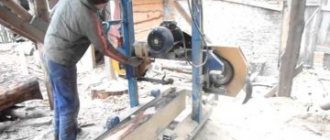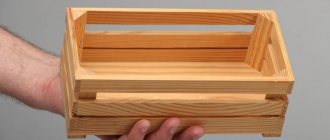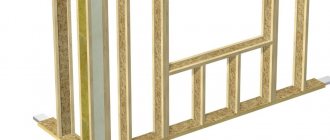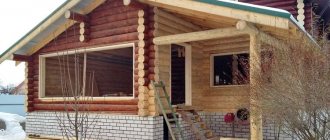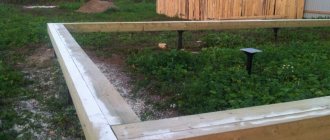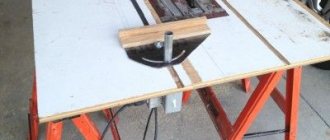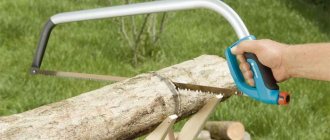Band saws are high-performance equipment that allows you to cut shaped and straight contours. The working tool is a flexible steel strip closed in a ring, equipped with a row of teeth along one edge.
The units began to be widely used only at the end of the 19th century, despite the fact that the first patent for a saw was received back in 1808 by an English designer. Then, in the coming years, such inventions were registered in France and the USA. The reason for such dislike for the band saw was the inability to accurately connect the cutting blade.
How does a band saw work?
A hand-held wood band saw consists of several blocks fastened together, the number of which can be increased or decreased, depending on the desired functionality of the tool. The main components of the band saw design are:
- frames with guides that help the movement of the tape;
- drive mechanism for belt tension;
- a device that holds the tape for cutting;
- lifting mechanism;
- belt drive with wedges;
- electric motor with a power level of 15 kW, or gasoline engine;
- latches of wooden parts on the frame;
- tap and container with water for wetting the product when sawing;
- rails for moving the mechanism.
Some models have special protective covers and mechanisms for a more stable position of the tool - these elements will make working with the device safer and more convenient. The essence of the principle of operation of a band saw is to fix a log between two guides and divide it using a cutting blade.
How to make such a tool yourself?
Before you start assembling the saw structure, prepare at least a simple drawing to clearly understand the dimensions and main components of the device. Most of the parts will be made of wood.
The frame is made of polished sheet glued with overlap. The minimum thickness of the mechanism parts is 2.5 cm. It is not recommended to use furniture boards or wooden slabs, as they are not strong enough.
The frame is made in the shape of the letter C. To make the body rigid and durable, overlays are attached to a wooden surface glued together from six layers. Make sure that the fragments are located only at right angles to each other.
Next, we assemble the moving part of the saw. We mount the profile to simplify the creation of the guide groove. With this profile, the sawing blade will be tensioned to the desired degree.
To strengthen the corner joints, we install additional fasteners. Next, the design is modified so that the frame moves freely in the grooves.
To create the spinning rollers, several pieces of wood are glued together and round pieces are cut out. Additional parts are installed on the wheels, which will make working with the device less noisy and more productive. After fixing the wheels, the saw blade is tensioned to ensure a stable position on the pulleys. A sufficiently tensioned blade will make precise and neat cuts.
Popular models
The Jet company produces about 50 types of machines for cutting metal and about 15 devices designed for processing wood. The most popular models for carpentry work on the Russian market are the following units.
- JWBS-10 is one of the cheapest and simplest saws with a power of 0.37 kW with one cutting speed and a maximum width of the sawn workpiece of 25 cm with a depth of up to 10 cm.
- JBS-12 100001021M – household model with a power of 0.8 kW. The maximum speed of the web is 800 m/min. The presence of a gearbox allows you to adjust the processing speed (2 speed options are available). The dimensions of the working table for this model are only 40x48 cm, and the maximum width of the cut made with its help is 30 cm. It is possible to tilt the working surface at an angle of up to 45°.
- JWBS-15-M is a semi-professional model with a power of 1.8 kW and a sawing speed of 760 m/min, allowing you to process workpieces up to 35.6 cm high.
- JWBS-18-T is a semi-professional machine powered by an industrial power supply with a power of 3.5 kW. It has two operating speeds - 580 and 900 m/min, which allows the device to be used for processing wood species of different hardness. The maximum height of the processed workpieces is 40.8 cm, and their width should be no more than 45.7 cm. The presence of a T-shaped groove allows you to cut out parts of complex shapes.
- JWBS-20-T is a powerful (6 kW) professional unit with two processing speeds (700 and 1280 meters per minute). The machine can accommodate blades with a width from 3 to 38 mm, the maximum cutting depth is 40.6 cm, and the width is 50.8 cm. This set of characteristics allows the unit to be used for sawing and dividing any type of wood in large-scale industries.
Such installations for metal processing enjoy the greatest success among Russians.
- J-349V is a household portable (weighing less than 20 kg) 1 kW machine with continuously adjustable processing speed (from 30 to 80 m/min), a rotating (up to 60°) frame and a maximum workpiece diameter of 12.5 cm.
- MBS-56CS is a household budget machine with a power of 0.65 kW with three speeds (20, 30 and 50 meters per minute), a rotating frame (from -45° to 60°) and a maximum diameter of processed workpieces - 12.5 cm.
- HBS-814GH is a semi-professional model with a power of 0.75 kW, the gearbox allows you to set speeds at 34, 50 and 65 m/min. The diameter of the workpiece is up to 20 cm.
- MBS-1213CS is a semi-professional version with a power of 1.5 kW with continuously adjustable speed in the range from 40 to 80 m/min and a maximum workpiece diameter of 30 cm.
- HBS-2028DAS is a professional semi-automatic machine with a power of 5.6 kW with a hydraulic pressure cylinder and continuously adjustable web speed from 20 to 100 m/min. The diameter of the processed parts is up to 51 cm.
- MBS-1012CNC is a professional CNC machine with a power of 1.1 kW for performing high-precision work on metal and stone.
What is useful to know to successfully work with the tool?
To make the work process easier, illuminate the work area using an ordinary lamp. It is better to install protective frames on the device, which will help remove chips and serve as guide elements. The optimal material for them is an MDF board with a thickness of at least 8 mm.
After installation of the device is completed, disinfect all wooden parts with an antiseptic solution so that rot and mold do not begin to appear soon after you start working with the device. A video with instructions will tell you in detail how to work correctly on a band saw on wood.
Operating principle of band saw machines
The basic principle of operation of band saws is to cut workpieces using a continuously moving closed steel band saw.
Thanks to this principle, band sawing machines have a number of advantages:
- Cutting is done quickly, accurately and cleanly.
- The work involves materials of various hardness, including especially strong metals.
- The devices cope well with workpieces of increased thickness.
- The equipment allows you to perform a number of fairly complex types of sawing, including curved sawing.
- The movement of the blade in the machines is carried out towards the work table, so recoil and ejection of the workpiece towards the operator is eliminated.
- The cut is very narrow, so there is little sawdust here, which saves the original material.
- Many band saws are cheaper than circular saws that offer similar functions.
- The units are quite compact and require a small area to operate. There are also desktop options.
- When performing operations, the machines make little noise, which allows them to be used in workshops located, for example, next to residential buildings.
Advantages and disadvantages of a band saw
This type of saw is successfully used in various types of work with wood and other materials and has a number of advantages:
- It is economical to use the tape model, as it makes very narrow cuts;
- high productivity of the device due to fast sawing speed;
- the moderate cost of the device is available due to its specific structure;
- does not create much noise during operation, which makes the work process more comfortable.
Along with numerous advantages, band saws also have some limitations and disadvantages:
- the complex process of setting up the device’s operating parameters, which can be a problem for a beginner;
- Due to the nuances of the mechanism’s design, it can only perform longitudinal cutting of wood.
Band sawing requires less initial investment.
The lower initial costs required for the enterprise to organize production is another significant factor in favor of band sawing. Although, to be honest, this factor can also play a cruel joke on the production worker. Reducing the cost of equipment clearly leads to a deterioration in the quality of products. And most importantly, on cheap band saw equipment, the inherent “features” of band sawing are much more pronounced.
Nevertheless, the fact remains that a band sawmill of the MV-2000 type, which allows you to fully saw fairly thick logs, will always be cheaper than a log sawing machine. And if we add here the lack of demands on the foundation, the ability to move relatively easily from place to place, reasonable power consumption, or even a diesel drive...
In practice, as it should be, everything is not so simple, otherwise it would be strange that band sawing, with such advantages, has not yet replaced disk sawing. As I mentioned above, band sawing has several significant features, failure to comply with which will negate all the advantages. But we will talk about the shortcomings, although I would still insist on the term “features,” in other materials.
How to choose the right saw?
If you choose the right tool, you will not have to repair band saws on wood anytime soon. Since there are a lot of options for choosing the appropriate tool model, quite a few people know how to choose the right device for their needs. We invite you to familiarize yourself with the most important and essential criteria for assessing the quality and functions of different saws. First of all, pay attention to the technical parameters of the models.
The cutting accuracy depends on the cutting speed and material feed. There are optimal speed ranges to achieve the best performance results.
The higher the performance of the device, the less resistant the saw blade will be to damage, deformation and wear.
The reputation of the manufacturer is also of great importance - if the reviews about the manufacturer are good and the reputation is reliable, then the product will most likely be of high quality.
Examine the condition of the main components of the device - the moving structure, portal, guide parts, pulleys and rollers.
A portal made of square pipes with reinforcing profiles is suitable for sawing wood parts. Otherwise, the main body may soon become bent during the cutting process.
But working on small parts won't hurt it that way. The best material for guide elements is solid metal that is resistant to deformation from loads.
The purpose of these recommendations is to help you achieve the best results from your wood band saws. Each band saw manufacturer uses its own specially developed steel. The band saw is required to: - be as stable as possible in the cut, which affects the quality of the surface of the material being cut; - so that its life expectancy is long (at least longer than that of its competitors); -so that it gives high sawing speed and, accordingly, high productivity; As you understand, any positive quality has accompanying side effects that affect the basic performance of the saw, and bandsaw manufacturers still have some work to do. The saw can make or break the entire sawing operation, so it requires careful attention on the part of operators and sharpeners, for whom it is very important to understand the theory of saws. To get the most out of the band saw you purchased, you need to do some things with it and with the machine: - prepare the saw depending on the type of wood being cut; - correctly install the saw blade on the pulleys: there should be a distance of 1.5...3 mm from the tooth cavity to the edge of the pulley. - the saw should be supported on both sides of the logs as close to it as possible. The correct position of the saw guide rollers gives it additional stability when sawing and the ability to cut at the highest speed, extending the life of the saw and increasing the amount of lumber cut by the saw. 1. TOOTH SHAPE The shape of the tooth has been developed and verified over the years. If you get the idea that the saw will cut regardless of the shape of the tooth, drive it away. 2. SAW WIDTH With proper operation, the band saw can serve until, as a result of re-sharpening, its width is reduced to 65% of the original. 3. SAW THICKNESS The thickness of the saw is determined by the diameter of the pulleys on the sawing machine. The thickness of the saw determines its service life and cutting accuracy. Theoretically, the thinner the saw, the longer its service life, since the bending stresses in it are lower, but on the other hand, the greater the risk of its failure as a result of an oversight or non-compliance with operating rules. Toe angle (rake angle), tooth set, sharpness and proper tooth height are the 4 most important factors in determining a saw's cutting ability. All 4 factors influence the productivity and quality of sawing. 4. TOOTH PITCH This is the distance between the top points of adjacent teeth. This setting always remains the same. During the sharpening process on working equipment, they do not change. 5. TOOTH HEIGHT The height of the tooth (sinus depth) is the distance from the lowest point of the sinus (socket) to the highest point of the tooth. The sinus is the space between the teeth that carries sawdust when sawing. When sharpening a saw, you must remove enough material from the saw blade to obtain the appropriate height. The depth of the tooth cavity is about 30% of the pitch. To ensure long service life of the saw, the groove should not be hardened during the sharpening process and should not contain stress raisers, scratches or burrs. The brittle burrs contain many cracks that can easily penetrate the saw, especially in the valleys where the greatest stress is present. After sharpening, all burrs must be removed from the teeth. If sharpening is done correctly, they are removed with a wooden block. 6. TOE ANGLE (FRONT ANGLE) This is the angle of inclination of the leading edge of the tooth relative to the 90° ordinate. It allows the tooth to grip the wood when sawing. The tooth must remove enough material so that the saw itself sinks into the log. The toe angle value is selected in such a way as to reduce the feed force. If the hook angle is too high compared to the feed rate, it will result in chatter, uneven (rough, rough) cuts and poor cut quality. The saw will be pulled sharply against the wood, with its leading edge possibly extending too far beyond the pulleys. If this angle is too small, the saw will have to be forced into the log, which will reduce the cutting speed and, as a result, reduce productivity. The size of the toe angle is determined by the type of wood and the performance standard. For most sawing operations, we recommend a hook angle of 10 to 12.5°15". On saws with an incorrectly selected hook angle, cracks may form, especially in the tooth cavities. 7. RADIUS AT TOOTH BASE The radius is built into the saw jaw and removes sawdust. During the sawing process, the force at the tip of the tooth acts against the tooth. This resistance creates a lot of “stress” at the base of the tooth. The radius spreads this stress over a large enough area to reduce the impact of stress on the lifespan of the saw. Too low a radius (small radius) on the surface will cause the saw to break. Too high (large radius) on the tooth leads to its rapid clogging, which causes a decrease in sawing speed and a reduction in the life of the saw. A tooth that is too high will have the same effect and will not hold the set well. 8. SHARPENING MACHINES The machine must be maintained in good condition. Play in bearings and guides is not allowed. Vibration of the grinding stone and play in the feed mechanism can damage the teeth. 9. GRINDING STONE MAINTENANCE Dressing the sharpening stone changes the angles and contours that make up the profile of the saw. It is clear that changing the profile carries the danger of changing the cutting characteristics of the saw. If the stone cannot be set accurately, the saw may develop what is known as an inconsistent profile after sharpening. Another potential danger is the loss of the center of the bosom: this leads to increased pressure on any one point, and the saw will fail prematurely. 10. TOOTH SETTING 10.1. Tooth set is the distance by which the tooth deviates in relation to the saw blade. Tooth setting is an important factor in saw performance. The more the tooth is set apart, the wider the cut will be and the more engine power required. The purpose of setting the teeth is to create clearance for the saw in the cut; in other words, it is necessary to reduce the friction between the wood and the saw so that the saw passes through the cut without overheating. The amount of wiring depends on the type of wood. The softer and more fibrous the wood, the more the teeth spread to reduce friction against the grain. Softwoods have coarse, long grains, while harder woods have virtually none. The latter also applies to frozen softwood, which is sawn with slight spacing. 10.2. How can you tell if the saw is set correctly? The layout can be considered optimal when there is a mixture of 65-70% sawdust and 30-35% air between the saw blade and the tree it is sawing. An external manifestation that the saw is set correctly is the ejection of approximately 80-85% of sawdust from the cut. If the saw is set too far apart, not enough sawdust is thrown out. If the saw is not widened enough, tightly compressed, hot sawdust remains on the surface of the board. It’s impossible to think of anything worse for a saw. The sawdust should be warm to the touch, not hot or cold. A saw that is set too far will likely cut in jerks, while a saw that is not set too far will cut in waves. If you are sawing logs with a diameter of 30 cm at a good speed and the sawdust is warm to the touch, then you should not try to cut a log with a diameter of 60 cm with a saw with the same saw blade, because it will have to remove twice as much sawdust from the cut. As you probably guessed, the divorce rate should be increased (by approximately 20%). The conclusion that suggests itself is that logs should be sorted by thickness before sawing them. Another very important point: only the upper third of the tooth should be spread, do not spread the tooth under the root; only the sharp corner at the very top of the tooth should be involved in the sawing process. Remember that the softer the wood you cut, the larger the spread should be. Sharpen the saw after hanging freely for 4-5 hours in an inverted state with minimal metal removal (several times if necessary), and then remove the burrs and re-shape. The basic rule: you get the best scam experimentally; you don’t need to look for formulas to calculate it. 10.3. Setting point on the tooth When setting the saw, special attention must be paid to the position of the saw in the setting device. The fold line (saw clamping edge) should be at the lowest point of the groove. The flex point (where the adjuster retainer presses against the tooth) should be approximately halfway up the tooth height. If the bend line is too high, the top of the tooth will bend, the saw will be unstable and the cut will be wavy. This reduces the sawing speed, and premature failure of the saw is also possible. Improper sharpening and routing of the saw is the main reason for premature saw failure. The entire process of sharpening and setting serves to extend the life of the saw. 11. CLEANING AND CHECKING SAWS Immediately after use, the saw must be cleaned of sawdust and resin, and before sharpening it must be thoroughly inspected. Otherwise, the grinding wheels may become clogged, which will lead to improper sharpening, for example, to hardening of the cavities after sharpening and to the subsequent occurrence of cracks. Release the tension on the saw as soon as you stop sawing. During operation, the saws heat up and, as a result, increase in length. As the saws cool down, they tend to shrink back to their original size and in the process, excess stress arises in the saw. In addition, the “memory” of the shape of the two pulleys remains in the saw, which greatly shortens the “life” of the saw. The ability of the saw operator plays a key role in obtaining maximum saw performance and lifespan, as he controls the many factors that affect the saw. The cutting speed depends on the type of wood. Softwoods (mainly conifers) have unequal (uneven) density of annual rings. Branches require careful monitoring of sawing speed adjustment. Hardwoods, due to their more uniform density (except for very low quality logs), can usually be cut faster and at a consistent speed. In general, all rocks differ in density (hardness). 12. LOGS 12.1. Log diameter It is naive to think that logs with a diameter of 20 cm and 80 cm can be sawed with the same result and speed. In the second case, the cutting area increases almost three times, and accordingly, the volume of sawdust removed increases three times. 12.2. Humidity As the logs dry, they become harder. In some species, drying out causes the softwood to be sawn like hardwood, at a slower rate. 12.3. Clean logs When sawing dirty logs, it becomes necessary to sharpen the saw too often. Proper sharpening leads to a reduction in saw width. The thinner the saw, the slower the cutting speed as it becomes unstable in the cut. 13. POSITION OF THE SAW GUIDE ROLLERS The correct position of the saw rollers ensures the stability of the saw in the cut. This stability allows the operator to cut at maximum speed. Cut as fast as you can to achieve a precise, even cut and produce quality material. 14. SAW LIFE Cracks in the cavities are one of the factors limiting the service life of band saws. Most cracks on band saw blades can be attributed to material fatigue due to "stress" caused by local changes in geometry or volume, or manufacturing defects in welding (breaks along the weld), or errors in sharpening and routing. Cracks can also occur if the quality of the steel is poor. 15. CUTTING SPEED The cutting speed is determined by the diameter and rotation speed of the pulleys. The normal linear speed of the saw is about 30 m/s. Increasing the linear speed of the saw and the feed rate may produce a cleaner cut, but the life of the saw will be reduced due to metal fatigue.
How to determine the quality of the canvas?
The correct choice of saw blade determines the service life of this important part. Therefore, you need to choose a blade that is suitable for the type of work you want to do with your bandsaw. The best steel for cutting blades is alloyed or carbon.
But a saw made from an alloy of two high-strength metals, which is characterized by increased strength and excellent cutting qualities, has also become popular. The higher the number of teeth per inch, the more accurate the cut will be. The optimal quantity is usually taken to be 8 teeth per inch. The width of the edge is not very important, but the blade will last longer if it is five times the height of the teeth.
Does the way the material is secured in a vice greatly affect the quality of the cut?
Yes. Each cutter has a specific vise capacity and maximum diameter of the material to be cut. When cutting materials such as profiles, I-beams, pipes, it is important to secure the material in such a way that the band saw cuts the cross section as accurately as possible. The way the material is held in a vise can have a big impact on the cost of cutting. In addition, the material being cut must be firmly fixed, eliminating vibration. In the case of a package of pipes and profiles, it may be necessary to use an additional upper vice and weld the elements together in the package.
